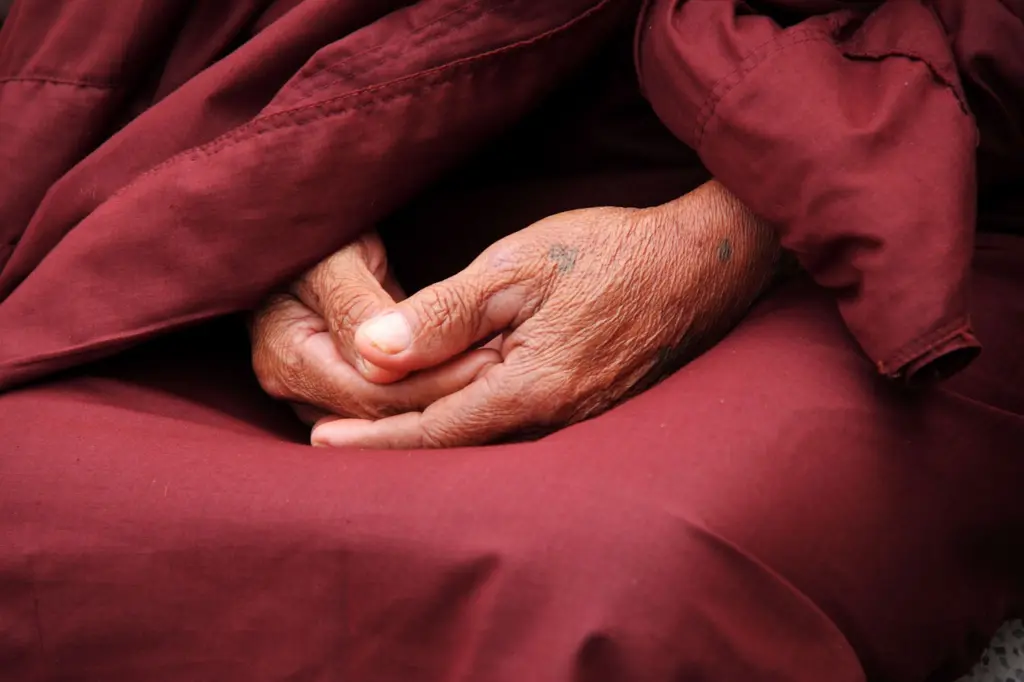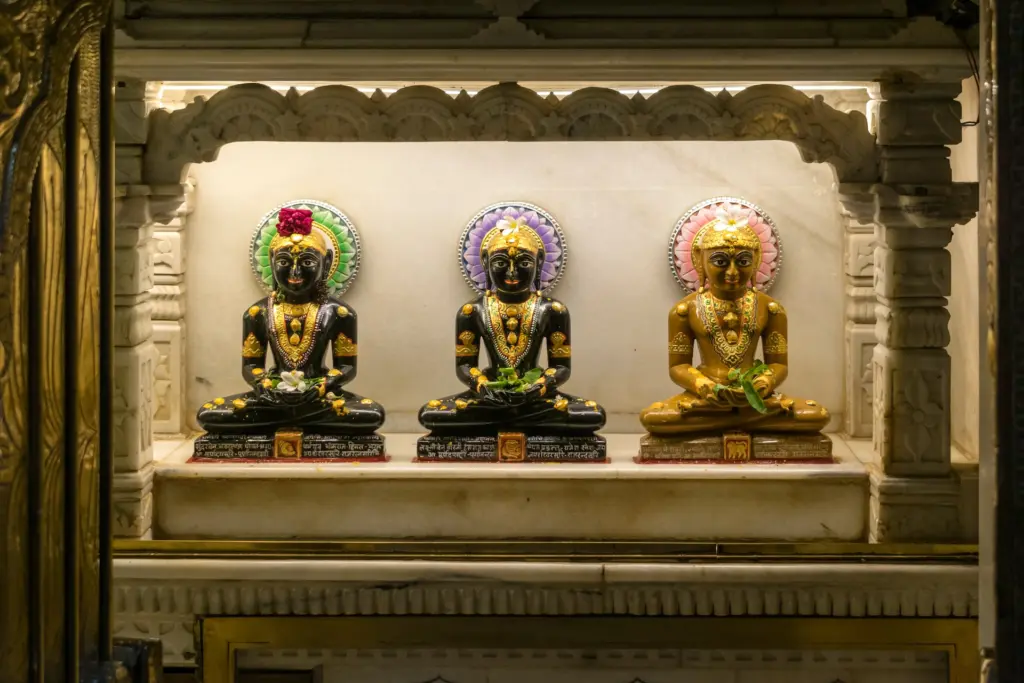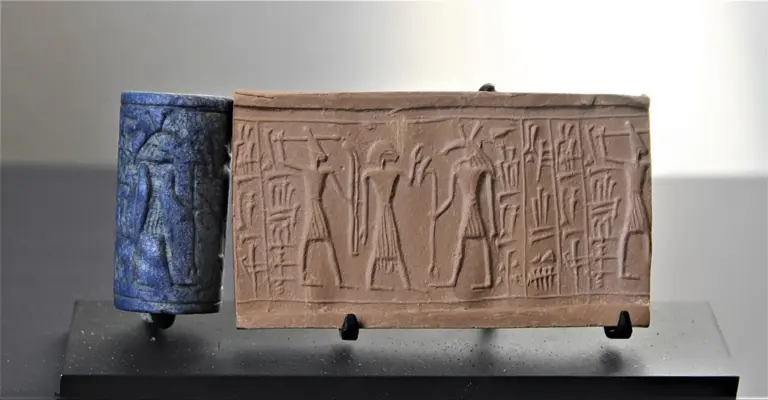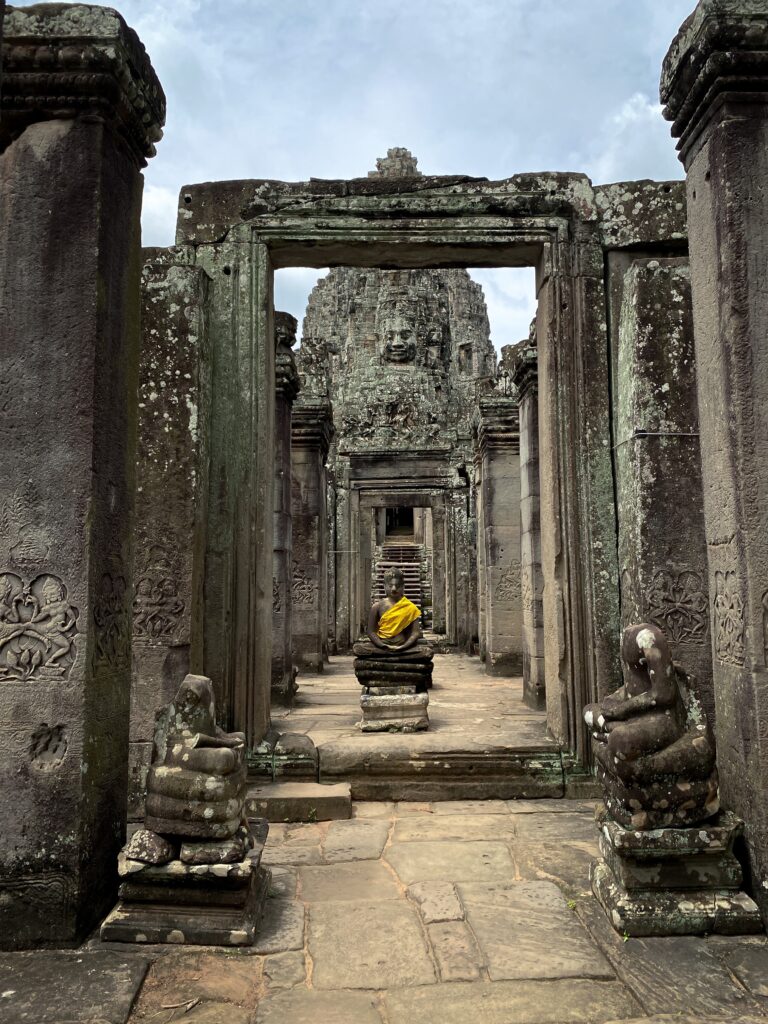Jainism, one of the world’s oldest and most profound religions, emerges from the serene landscapes of ancient India. Rooted in the principles of non-violence, self-discipline, and spiritual liberation, it presents a path that intricately weaves together philosophy, ethics, and spirituality.
Jainism illuminates the soul’s journey towards ultimate liberation and emphasizes living a life of harmony and respect for all forms of life.
Together, let’s unravel Jainism’s timeless wisdom and uncover the beauty of a faith that celebrates life in its most peaceful form.
Table of Contents
Toggle
What is Jainism?
Jainism was founded in the 6th century BCE during a time of religious renewal in India, a period that also saw the rise of Buddhism along with the predominant Hinduism.
The faith is named after the Jinas, spiritual conquerors who have achieved liberation through self-discipline and ascetic practices.
Jains believe in a universe composed of living souls (jiva) and non-living matter (ajiva). The soul’s entanglement with matter, caused by karma resulting from selfish actions, is what leads to rebirth.
Therefore, liberation (moksha) is achieved through purifying the soul of karmic attachments, primarily by practicing non-violence, truthfulness, chastity, and non-attachment.
Jainism is not just a religion but a way of life. It emphasizes a disciplined lifestyle with practices like vegetarianism, fasting, and meditation.
Furthermore, the Jain community is divided into two major sects: Digambara (sky-clad), who believe that asceticism involves renunciation of all possessions including clothing, and Svetambara (white-clad), who wear simple white clothing.

Who are the Central Figures in Jainism?
Jainism reveres a succession of spiritual teachers known as Tirthankaras. These enlightened beings are considered guides for those seeking spiritual liberation. There are 24 Tirthankaras in Jain tradition, each having achieved liberation from the cycle of birth and death. They are not seen as gods, but rather as exceptional human beings who attained ultimate knowledge and taught the path to enlightenment.
Rishabhanatha (Adinatha): Recognized as the first Tirthankara, Rishabhanatha is often considered the founder of Jainism in its current form. He is credited with establishing social institutions such as marriage and agriculture in ancient India.
Parshvanatha: The 23rd Tirthankara, Parshvanatha, is a historical figure believed to have lived around the 8th century BCE. He is associated with fourfold restraint: non-violence, non-lying, non-stealing, and non-possession.
Mahavira (Vardhamana): The most prominent Tirthankara, Mahavira is the 24th and last Tirthankara of the present time cycle. Born as a prince in the 6th century BCE, he renounced worldly life to pursue spiritual awakening. His teachings form the core of current Jain doctrine.

What is the Sacred Text of Jainism?
The sacred texts of Jainism are known as the Jain Agamas. They were originally transmitted orally and were later compiled and written down by Jain monks. The content of the Agamas includes the direct teachings of the Tirthankaras.
The Jain Agamas are divided into two main categories, based on the major sects of Jainism:
Svetambara Texts: The Svetambara sect’s scriptures include the 11 Angas and several Upangas, Chedasatras, Mulasutras, and Prakirnaka Sutras. The Angas are considered the primary canonical texts, containing the teachings of Mahavira.
Digambara Texts: The Digambara sect does not accept the Svetambara texts as authentic. They believe that the original Jain Agamas were lost over time. The Digambara literature includes texts like the Satkhandagama and Kasayapahuda, written by later Acharyas (spiritual leaders) such as Kundakunda, Umasvati, and others.
The Jain scriptures emphasize right knowledge, right faith, and right conduct, which are integral to the path of liberation in Jainism. Despite differences in the acceptance of texts between the two sects, the core teachings and philosophical essence remain consistent across Jain literature.
What are the Core Beliefs of Jainism?
Karma, Samsara, and Moksha
In Jainism, karma is viewed as a physical substance that attaches to the soul because of one’s actions, thoughts, and speech. This attachment distorts the soul’s innate qualities of perfect knowledge, perception, and happiness, leading to a cycle of rebirths (Samsara).
Jain texts categorize karma into various types, with “Ghati Karma” affecting the soul’s perception and knowledge and “Aghati Karma” influencing the body and the environment of the soul’s rebirth.
Karma particles are attracted to the soul due to passions such as anger, ego, deceit, and greed.
Virtuous actions attract good karma, leading to pleasant experiences, while harmful actions attract bad karma, resulting in suffering. Jains aim to halt the influx of new karma and shed existing karma through disciplined living, ethical behavior, meditation, and ascetic practices.
Liberation (Moksha) is achieved when the soul is entirely free of all karmic particles, attaining a state of perfect knowledge, perception, and bliss.

Ratnatraya
Ratnatraya, or the Three Jewels, is a fundamental concept that outlines the path to liberation. It consists of three key components: Samyak Darshana (Right Faith), Samyak Jnana (Right Knowledge), and Samyak Charitra (Right Conduct). These elements work in harmony to guide an individual towards spiritual awakening and liberation from the cycle of rebirth.
-
Samyak Darshana: This refers to having faith in the true nature of reality as revealed by the Tirthankaras. It involves a correct understanding and acceptance of the fundamental principles of Jainism, such as the belief in the soul, karma, and the cyclical nature of the universe. Right Faith is the foundation for developing Right Knowledge and Right Conduct.
-
Samyak Jnana: This is the accurate understanding of Jain doctrines, including the nature of the soul, the material world, and the dynamics of karma. It involves acquiring knowledge that is comprehensive, free from doubt and delusion. Right Knowledge then provides the intellectual framework necessary for practicing Right Conduct.
-
Samyak Charitra: This encompasses living a life according to Jain ethical principles. It involves practicing non-violence (ahimsa), truthfulness (satya), non-stealing (asteya), chastity (brahmacharya), and non-possessiveness (aparigraha).
Jiva and Anjiva
The concepts of Jiva and Ajiva represent the living and non-living aspects of the universe:
Jiva (Living Substances): Jiva refers to the soul consciousness, present in all living beings, from the smallest microorganisms to humans and celestial beings. It is characterized by the capacity for knowledge and is inherently pure, possessing infinite knowledge, perception, power, and bliss.
Ajiva (Non-Living Substances): Ajiva encompasses everything in the universe that does not have a soul or consciousness. This includes matter, space, time, motion, and rest. Material substances (Pudgala) in Ajiva are what constitute karma in physical form, adhering to the soul and affecting its experiences and rebirth.
The interaction between Jiva and Ajiva is central to Jain metaphysics. The soul’s liberation is achieved by shedding the karmic particles accumulated from interactions with Ajiva. This liberation is the ultimate goal in Jainism, where the soul finally regains its inherent qualities of perfect knowledge and bliss.

Anekantavada
Anekantavada emphasizes the multiplicity of reality. It holds that truth and reality are multifaceted, and no single human perspective can completely represent the whole truth. This principle arises from the understanding that different viewpoints can offer valid, yet partial, perspectives of a complex reality.
This principle cautions against dogmatism in matters of knowledge. It promotes a flexible approach to truth, acknowledging the limitations of human knowledge and perception.
The parable of the seven blind men and the elephant is a famous story often used to illustrate the principle of Anekantavada.
In the story, seven blind men encounter an elephant for the first time and seek to understand what it is like by touching it. Each blind man feels a different part of the elephant’s body, but only one part, such as the side, the tusk, the trunk, the knee, the ear, the tail, or the tusk.
- The man who feels the side says the elephant is like a wall.
- The one who feels the tusk declares it’s like a spear.
- The person touching the trunk argues it’s like a snake.
- The man feeling the knee insists it’s like a tree.
- The one who touches the ear believes it’s like a fan.
- The man holding the tail claims it’s like a rope.
- The one feeling the other tusk asserts it’s like a solid pipe.
Each blind man is convinced he is correct based on his limited experience. The story illustrates how each person’s understanding of reality is limited by their perspective. No single interpretation is the complete truth, but rather a part of a greater whole.
What are the Core Principles of Jainism?

Ahimsa
Ahimsa, or non-violence, is the most fundamental and well-known principle in Jainism.
In Jainism, ahimsa is not just about abstaining from physical violence; it also involves avoiding harm in speech and thought, as Jains believe that violent thoughts and words can bind the soul with karma.
The practice of ahimsa leads Jains to adopt vegetarianism and to take meticulous care in their daily activities to avoid harm to even the smallest living beings. This deep respect for all forms of life is central to Jain ethics and spirituality.
The Ahimsa Hand symbol (not to be confused with the Hamsa Hand) depicts a hand with a wheel in the palm. The hand symbolizes non-violence, often used as a universal sign to stop violence, and signifies peaceful relations with all beings.
At the center of the hand is the Dharmachakra or the Wheel of Dharma, representing the cycle of birth and death and the importance of living a righteous life.
The symbol includes the Sanskrit inscription for Ahimsa at the bottom or around the wheel.
Asteya
Asteya refers to the principle of non-stealing, encompassing a broad ethical injunction against taking anything that is not willingly given.
This principle extends to avoiding the appropriation of others’ ideas, time, or any form of property without consent. Asteya also implies not being deceitful in one’s interactions. It advocates for respecting the rights and possessions of others, promoting honesty and integrity in all aspects of life.
Aparigraha
Aparigraha is the principle non-attachment. It involves limiting one’s possessions to what is necessary and avoiding the accumulation of material wealth and emotional attachments that can be seen as obstacles to spiritual growth.
This principle encourages Jains to practice simplicity, detachment, and contentment with what they have. Aparigraha also implies being mindful of the environment and consuming resources responsibly, reflecting an awareness of the impact of one’s actions on other beings and the world.

Brahmacharya
While Brahmacharya is often associated with celibacy, its deeper meaning encompasses a disciplined mode of conduct that is conducive to spiritual growth.
This includes control over one’s senses, thoughts, and actions in a manner that aligns with the pursuit of truth and spiritual awakening.
It’s about living a life that is in harmony with higher spiritual values and minimizing worldly distractions.
Syadvada
Syadvada is often associated with Anekantavada.
The essence of Syadvada is the theory of conditioned predication, which suggests that any statement about reality must be qualified in various ways to acknowledge the multiple aspects and perspectives of that reality. This is often expressed through the use of the term “syad,” which means “from one perspective.“
For example, a statement in Syadvada would not simply assert “X is true,” but rather “from one perspective, X is true.” This approach recognizes that any given statement has limitations and is only conditionally valid, depending on the context and perspective.
Syadvada thus encourages a respectful and open-minded approach to understanding, avoiding dogmatism and acknowledging the limitations nature of human knowledge.
Satya
Satya refers to the principle of truthfulness, which emphasizes speaking the truth in a way that does not cause harm to others.
The practice of Satya in Jainism involves careful consideration of one’s words, ensuring they are not only true but also kind, necessary, and beneficial. This principle acknowledges the power of speech and its impact on others, urging Jains to use their words responsibly and compassionately.

What are the Practices of Jainism?
The practices of Jainism are deeply rooted in its core principles and beliefs. These practices are designed to purify the soul, minimize karmic accumulation, and ultimately lead to liberation. Here are some key practices followed by Jains:
-
Meditation: Regular meditation and prayer are central to Jain practice, helping to cultivate inner peace, self-discipline, and spiritual awareness.
-
Fasting: Observing periodic fasts and other forms of asceticism, which are believed to purify the body and soul and reduce karmic bondage.
-
Rituals: Performing rituals and worship, including Puja (worship rituals) and Arti (offering of light), often at temples, as a way of paying respect to Tirthankaras and spiritual teachers.
-
Charity: Engaging in acts of charity and community service, reflecting the Jain emphasis on compassionately helping others.
-
Pilgrimage: Undertaking pilgrimages to sacred Jain sites such as Mt. Kailash, which is seen as a way of earning spiritual merit and deepening devotion.
-
Vegetarianism: Following a vegetarian diet, often also avoiding root vegetables to prevent harm to small organisms, as part of the practice of non-violence.

Jainism by Country
The largest concentration of Jains is undoubtedly in India, with estimates suggesting there are about 4 to 5 million Jains, making up less than 1% of the country’s population. Indian states like Maharashtra, Rajasthan, Gujarat, and Madhya Pradesh have significant Jain populations.
Outside of India, Jain communities, though much smaller in number, are found in several countries, often as part of the Indian diaspora. In the United States, for instance, the Jain population is estimated to be around 79,000, according to a 2012 Pew Research Center report. Jains in the U.S. have established numerous temples and cultural centers and have formed organizations such as the Federation of Jain Associations in North America (JAINA) to serve their communities.
In East Africa, countries like Kenya and Tanzania have historical Jain communities, established by migrants who arrived there in the late 19th and early 20th centuries. These communities have since become smaller due to migration to Western countries, but they still maintain Jain temples and cultural practices.
Other countries with smaller Jain populations include the United Arab Emirates, Belgium, Japan, Singapore, Hong Kong, and Australia.

What are the Customs of Jainism?
Use of Jain Symbols: Incorporating Jain symbols like the Swastika, Ahimsa symbol, and Ashtamangala (Eight Auspicious Symbols).
Jain Weddings: Feature unique rituals like “Mangal Pheras” and “Kanyavaran,” with an emphasis on simplicity, religious chants, and a smaller number of circumambulations around the fire compared to other Indian traditions.
Paryushana Festival: A significant annual event focusing on fasting, prayer, and self-reflection. The festival culminates in the ritual of forgiveness known as “Kshamavani,” where community members seek and offer forgiveness to one another.
Diwali in Jainism: Marked as the anniversary of Mahavira’s attainment of Moksha, this festival is observed with lighting lamps, fasting, and the reading of the final sermon of Mahavira.













